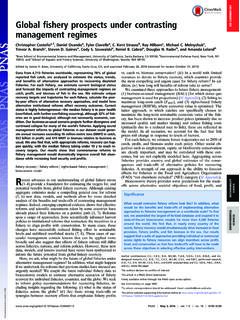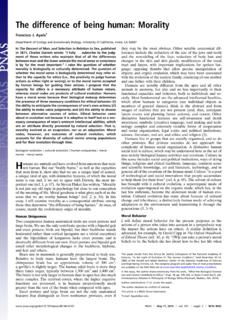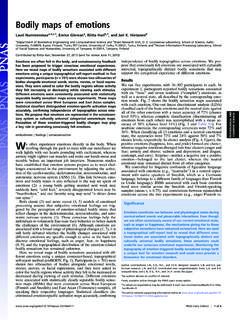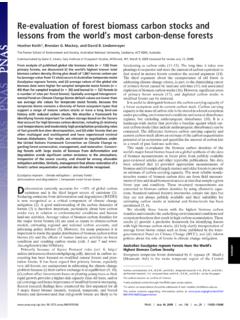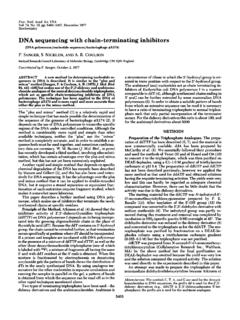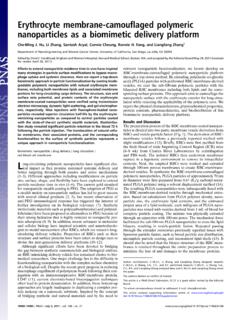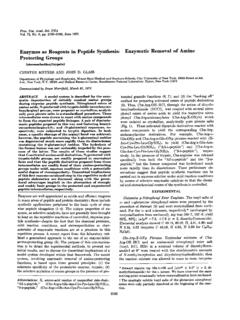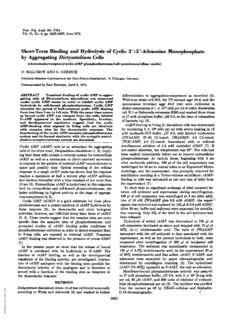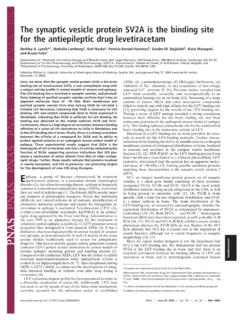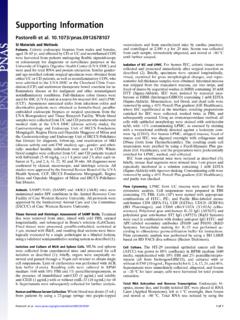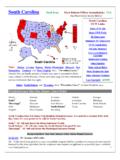Transcription of Extraneous factors in judicial decisions - pnas.org
1 Extraneous factors in judicial decisionsShai Danzigera,1, Jonathan Levavb,1,2, and Liora Avnaim-PessoaaDepartment of Management, Ben Gurion University of the Negev, Beer Sheva 84105, Israel; andbColumbia Business School, Columbia University, New York,NY 10027 Edited* by Daniel Kahneman, Princeton University, Princeton, NJ, and approved February 25, 2011 (received for review December 8, 2010)Are judicial rulings based solely on laws and facts? Legal formalismholds that judges apply legal reasons to the facts of a case in a ra-tional, mechanical, and deliberative manner. In contrast, legal real-ists argue that the rational application of legal reasons does notsufficiently explain the decisions of judges and that psychological,political, and social factors influence judicial rulings. We test thecommon caricature of realism that justice is what the judge atefor breakfast in sequential parole decisions made by experiencedjudges. We record the judges two daily food breaks, which result insegmenting the deliberations of the day into three distinct deci-sion sessions.
2 Wefind that the percentage of favorable rulingsdrops gradually from 65% to nearly zero within each decisionsession and returns abruptly to 65% after a break. Ourfindingssuggest that judicial rulings can be swayed by Extraneous variablesthat should have no bearing on legal |legal realism|mental depletion|expertdecisionmaking|ego depletionDoes the outcome of legal cases depend solely on laws andfacts? Legal formalism holds that judges apply legal reasons tothe facts of a case in a rational, mechanical, and deliberativemanner (1, 2). An alternative view of the law encapsulated in thehighly influential 20th century legal realist movement is rooted inthe observation of US Supreme Court Justice Oliver WendellHolmes that the life of the law has not been logic; it has beenexperience (3). Realists argue that the rational application oflegal reasons does not sufficiently explain judicial decisions andthat psychological, political, and social factors influence rulings aswell (4). The realist view is commonly caricaturized by the tropethat justice is what the judge ate for breakfast (5).
3 We empiricallytest this caricature in the context of sequences of parole decisionsmade by experienced judges (mean experience = y, SD = )and, in so doing, demonstrate how Extraneous factors can swayhighly consequential decisions of expert decision research suggests that making repeated judgments or deci-sions depletes individuals executive function and mental resources(6), which can, in turn, influence their subsequent decisions . Forinstance, sequential choices between consumer goods can lead to anincrease in intuitive decisionmaking (7) as well as a reduced toler-ance for pain in a subsequent task (8). Sequential choices and theapparent mental depletion that they evoke also increase people stendency to simplify decisions byaccepting the status quo. Germancar buyers, for instance, were more likely to accept the default at-tribute level offered by a manufacturer later in a sequence of attri-bute decisions than earlier, particularly when these choices followeddecisions between many alternatives that had required more mentalresources to evaluate (9).
4 These studies hint that making repeatedrulings can increase the likelihood of judges to simplify their deci-sions. We speculate that as judges advance through the sequence ofcases (whose order appears to be exogenously determined; see belowfor a detailed discussion), they will be more likely to accept the de-fault, status quo outcome: deny a prisoner and MethodsOur data consist of 1,112 judicial rulings, collected over 50 d in a 10-moperiod, by eight Jewish-Israeli judges (two females) who preside over twodifferent parole boards that serve four major prisons in Israel. Our prisonersample consisted of 727 Jewish-Israeli males ( ), 326 Arab-Israeli males( ), 50 Jewish-Israeli females ( ), and 9 Arab-Israeli females ( ).The two parole boards process 40% of all parole requests in the prisons house felons convicted of crimes such as embezzlement, assault,theft, murder, and rape. Each parole board is composed of one judge, aswell as a criminologist and a social worker who provide the judge withprofessional advice.
5 For each day we obtained the entire set of rulings. Themajority of the decisions in our sample ( ) consist of parole requests;the remainder consist of parolee requests to change the terms of their pa-role ( , a request to remove a tracking device) or requests by parolecandidates to change the terms of their incarceration ( , a request forprison relocation). Our database includes the legal variables that appear inthe casefile: number of previous incarcerations, gravity of crime committed,months served, and whether a rehabilitation program would be availableshould the prisoner be granted parole ( of prisoners had such a pro-gram in place). [A judge with 40 years of experience on the bench, twocriminal attorneys, and two prison wardens with 10 years experience servingon the parole board, independently ordered the gravity of offense for the 7classes of crimes committed. Ordering was identical for thefive experts, andranged from misdemeanor (1) to felony (7).] The judge was not providedthese details in advance; the information was provided by a clerk only whenthe prisoner (and his or her attorney) appeared before the parole day a judge considered 14 35 cases (seeSI Materials and Methods, S1for details) in succession (M= , SD = ), and each case deliberationlasted 6 min (M= , SD = , Max = ).
6 Our data include the timeof day in which the prisoner s request was considered and its ordinal posi-tion in the sequence of decisions for that ,inpart,byinterventionssuchasviewingscen esofnature(10),shortrest(11),experiencin gpositive mood (12), and increasing glucose levels in the body (ref. 13; fora review see ref. 14). In our data, we record the two daily food breaks that thejudge takes a late morning snack and lunch which serve to break up theday s deliberations into three distinct decision sessions. Such a break mayreplenish mental resources by providing rest, improving mood, or by in-creasing glucose levels in the body. The meal is typically served to the judge atthe bench and its timing, which is determined by the judge, varies by day. Inour sample, the start time of the morning food break ranged between 9:49and 10:27 AM (snack consisting of a sandwich and fruit) and lasted an averageof min (SD = , min = 6, max = 106); the start time of the afternoon(lunch) break ranged between 12:46 and 2:10 PM and lasted an average min (SD = , min = 15, max = 110).
7 The breaks were taken after anaverage of cases (SD = , min = 2, max = 28) in the morning session cases (SD = , min = 2, max = 25) in the postsnack/prelunch , our data enable us to test the effect of the ordinal position of a case onthe judge s decision and the effect of the judge having taken a break to judges decisions are classified into two categories, accept request and reject request. Under the reject category, we include bothfinalrejections as well as rejections that include a stipulation for review at a laterdate (such delay decisions constitute of the reject category). On av-erage, such reviews occur 1 mo after the initial parole board review. Thus,a decision to delay effectively maintains the status quo for the , of prisoner requests in our sample were contributions: , , and designed research; , , and per-formed research; analyzed data; and and wrote the authors declare no conflict of interest.*This Direct Submission article had a prearranged and contributed equally to this whom correspondence should be addressed.
8 E-mail: article contains supporting information online |April 26, 2011|vol. 108|no. 17|6889 6892 SOCIAL SCIENCESR esultsWefind that the likelihood of a favorable ruling is greater at thevery beginning of the work day or after a food break than later inthe sequence of cases. This pattern is readily evident in Fig. 1,which plots the proportion of favorable rulings by ordinal positionfor 95% of the observations in each decision session. The plotshows that the likelihood of a ruling in favor of a prisoner spikes atthe beginning of each session the probability of a favorableruling steadily declines from to nearly zero and jumps backup to after a break for a meal. Fig. 2 AandBpresentsa histogram of the probability of a favorable ruling for cases ofsimilar legal characteristics that appeared in one of the threeordinal positions at the beginning versus at the end of a decisionsession; from the perspective of the prisoner, there is a clearadvantage to appearing at the beginning of the session ( , eitherat the beginning of the day or immediately following the break).
9 To account for the possible role of covariates in the patternsdepicted in Figs. 1 and 2, we used a logistic regression with rulingsas the dependent variable and a judge-specificfixed effect tocontrol for the idiosyncratic tendencies of each judge (Table 1).The key predictors were several different indicators of a case sordinal position: (i) dummy variables indicating thefirst threecases in a session, included to examine how judgments immediatelyafter a break differ from those that preceded or succeeded them;(ii) dummies indicating in which of the three daily sessions the casehad appeared; and (iii) two types of ordinal position counters (oneindicating the ordinal position within the session and the otherindicating the ordinal position within the day, each used in a dif-ferent regression specification). The covariates included all of thelegal attributes of the case that were available in the casefile (se-verity of crime, months served, previous incarcerations, and re-habilitation program), prisoner demographics (sex, nationality),and the proportion of favorable rulings to that point in the day.
10 Thepurpose of the latter was to control for the possibility that thejudges have a daily quota of favorable decisions that they expectto render, which, oncefilled, are followed by unfavorable positive sign and significance of the dummy variables in-dicating thefirst three cases in each session confirms that thepattern in Fig. 1 holds even while controlling for the legalattributes of the case and for the overall tendency of the judges torule against the prisoner as the number of cases before themmounts ( , the main effect of making repeated decisions ). Theresults are nearly identical when we restrict our analysis only toparole requests (Table S1) and in analyses where we drop the twomost frequently occurring judges (Table S2) and each of thejudges in our sample (Tables S3 S10). In addition, a plot similarto Fig. 2 for each judge shows that every judge in our sample wasmore likely to rule in favor of a prisoner at the beginning ofa session than at the end of a session (Fig.)
